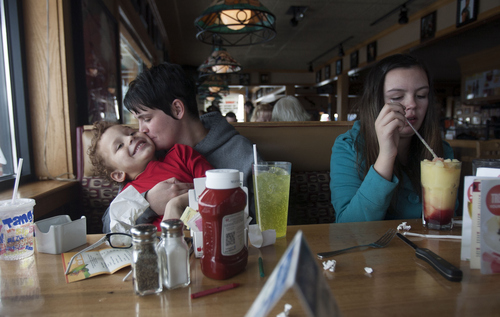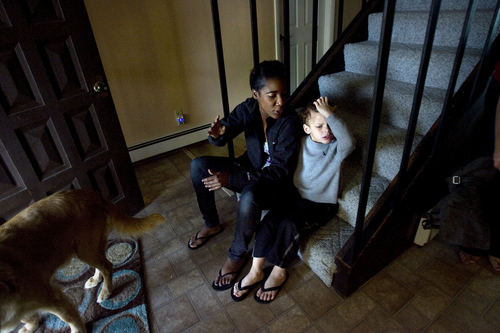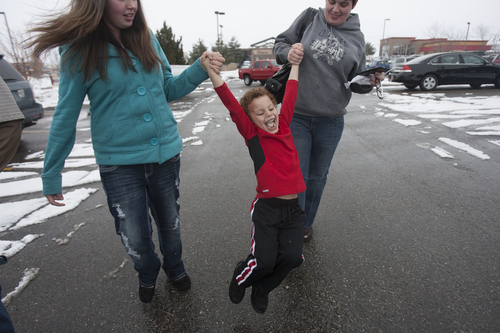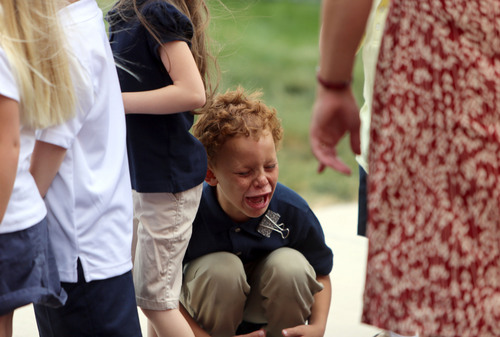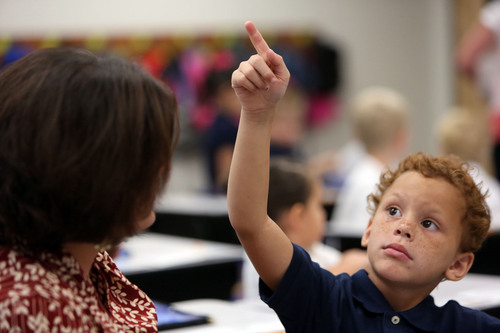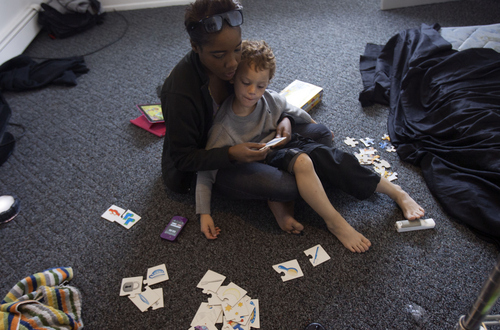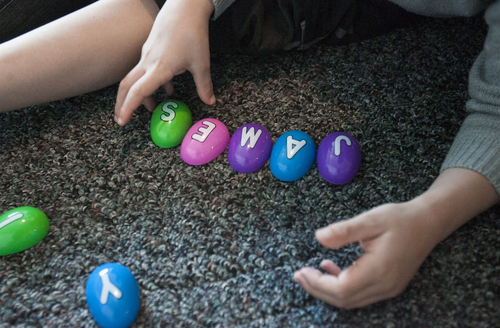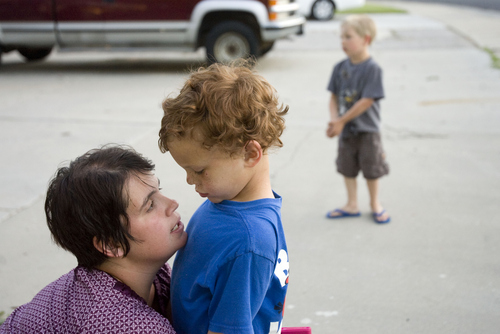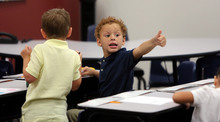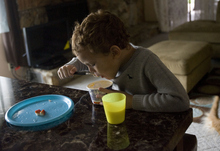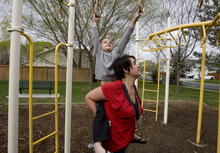This is an archived article that was published on sltrib.com in 2014, and information in the article may be outdated. It is provided only for personal research purposes and may not be reprinted.
Erda • Kids jockey to hang up coats. A girl sits crumpled on the floor, crying, and a boy hides behind a chair, protesting, "I don't like kindergarten."
James Turner joins his reluctant classmates slowly, face down, but manages a smile for an aide, assigned to help him adjust to "big boy" school.
He fidgets in his chair and grabs for a crayon from a classmate who elbows him off. But the 5-year-old is easily re-directed, listens and responds to his teacher and melts down only once, after falling off a slide on the playground.
"He's doing great. Not in a million years did I think he could sit and focus like that," says his mom, Angie Watterson, watching from the back of the classroom in tears on this August 2013 morning, her son's second day of school.
James, who has autism, has come a long way.
But that's the result of years of therapy — therapy that isn't finished.
The Stansbury Park boy is one of about 300 Utah children selected in a lottery to receive free autism behavioral therapy through Medicaid. The program has, by all measures, been a success, but it will expire in June if lawmakers don't pass HB88, a bill to permanently extend it.
Watterson prays they do. She also wants lawmakers to mandate insurance coverage of the expensive Applied Behavioral Analysis (ABA) therapy.
"Autistic kids absolutely have the ability to do amazing things. They have to be given the tools," she says.
—
'A powerful program' • The Medicaid lottery was one of three experiments created to convince doubting lawmakers that ABA works. Legislators have so far declined to pass a mandate, which would require certain categories of insurers to cover the treatment.
Early fears that the pilot was designed to fail, based on its low pay, were eased when the Utah Department of Health agreed to reimburse therapists more.
Then families, thrilled to have won a coveted slot, met with delays. It took four months for some in rural parts of the state to receive their first therapy visit.
Delays in care were largely unavoidable because there weren't enough trained ABA providers in Utah to handle the overnight influx of hundreds of children.
But with an army of trained therapists now in place, it takes at most a month from the time a family wins a lottery slot to their first therapy session, said Tonya Hales, who oversees community-based Medicaid services for the health department.
"It's a powerful program that changes our lives every day," said Heather Humphreys of Nibley, testifying in February at a legislative hearing.
The lottery came at the perfect time for Humphrey's daughter, Samantha — within weeks of her autism diagnosis at the age of 2 — but too late for her teenage daughter who also has autism.
Samantha "is the most severe," and did not speak, Humphreys said. "We had wrapped our house in packing bubbles, because she would flop to the floor and bash her head against anything solid. Tantrums would last an hour or more. She would bolt from the house ... One morning we woke up at 3 a.m. and found her in the sandbox outside."
Now a 3-year-old, "Sammy" expresses herself with language, Humphreys said.
"Six months ago, she said 'Mommy' for the first time ever ... [She] knows how to ask for help better than my 14-year-old, who benefitted from years of therapy but didn't get ABA."
—
'Not solving a problem' • HB88 would continue the program and require the state employee health plan to cover autism treatment, said its sponsor, Rep. Ronda Menlove, R-Garland.
It would meet the needs of about 10 percent of Utah children in need of ABA services, Menlove said. "We're making a dent, but we're not solving a problem."
Another bill, sponsored by emergency room physician Sen. Brian Shiozawa, R-Cottonwood Heights, would further chip away at the coverage gap by requiring coverage by state-regulated health insurers, those selling plans to individuals and small businesses. The bill would also cover state employees and the Children's Health Insurance Program.
The mandate would not apply to Medicaid or large employer health plans, but it would ease pressure on the lottery, said John Owen, director of the Utah Autism Coalition. Many big companies, realizing the benefits, are adding autism coverage on their own, he added.
Utah is believed to have the highest rate of autism in the country. It's one of 16 states that don't require insurers to cover autism treatment.
Many families default to therapy provided through public schools, which doesn't meet strict ABA standards and isn't frequent enough, said Watterson.
Kids need early, evidence-based interventions to prepare them for school and independent living, she said. "Autism doesn't just affect the child. It affects the families and schools and community."
—
'Changed my outlook' • By age 2, James could say 150 words and was potty trained. But six months later, "everything just stopped."
The state's early intervention program urged Watterson to have him tested for autism. "But no one could see him. Appointments everywhere, the University of Utah and Primary [Children's Hospital], were nine months out," she said.
Just after he turned 3, James was diagnosed by the Children's Center with autism, sensory processing and attention-deficit hyperactivity disorders.
He was functioning like an 18-month-old. He barely slept and had started banging his head and smearing feces on walls (a result of his sensory-seeking disorder).
A psychologist told Watterson that James probably wouldn't talk until age 7 or 8, and probably wouldn't attend mainstream school or live on his own.
She tried a special needs preschool. She searched online and bought books, creating her own at-home therapy program.
To build motor skills, she had James string beads. To re-direct his sensory-seeking habits, she let him play with chocolate pudding in the tub.
Then, in spring 2012, she found an ABA therapist who charged $20 an hour for up to 10 hours a week. ABA therapy can run as high as $35 to $100 an hour.
Watterson's first therapy goal for James was to have him sit at the kitchen table for a full meal. He started out sitting for 30 seconds, and was rewarded with an M&M. After two weeks he could sit for one minute.
The same slow process has taught him to count to 20 and identify letters, to look people in the eye when talking, to say "please," "thank you" and "excuse me."
ABA works by positively reinforcing desired behaviors. Skills are taught through repetition, and it can take years to master one and move onto the next.
"It took six months to get James to sit through dinner," said Watterson. "It will take me a year to teach him to tie his shoes. It's definitely changed my outlook of parenting."
She's convinced ABA works for James. But his therapy stopped in September 2012 after Watterson "wiped out" her savings.
James started losing skills.
—
'This is huge' • On an afternoon in January 2013, James can't sit still for long. He walks across the room on his tip toes. He asks his mother for "huggies" and climbs on her. He grabs a video game controller and groans. "I want to play some Lego Batman."
"OK, what do you say? What do you ask mommy?" Watterson prompts.
"I want to play Lego Batman, please," he says.
"So what do you need me to do?"
"Set up my Lego Batman toy," he responds.
That interaction — instead of him yelling — shows the lingering benefits of his ABA therapy, Watterson says.
James has won a spot in Utah's lottery and will resume therapy in March — in time, Watterson hopes, to ready him for kindergarten in the fall.
By the end of summer, James is making eye contact almost 100 percent of the time. On an evening in July, he plays on the front lawn with two friends he has invited to a sleep-over.
"This is huge, to know he's making friends," Watterson says.
James is working on sharing, forgoing wants and expressing, instead of acting on, his feelings.
"He still has 5-year-old meltdowns, but they're 5-year-old meltdowns, not 2-year-old meltdowns," she says. "Academically, James is very smart if we can get the behaviors out of the way."
—
'It's changed his life' • Today, six months into James' kindergarten year, the focus is on academics. There have been bumps, says Watterson.
For a spell James was refusing to go to school because he hated math, she says. His ABA therapist suggested one-on-one math instruction with his para-educator to reduce distractions and it worked.
Initially the school had to phone Watterson two to three times a day to intervene with James. Now it's maybe once a month, she says.
"Having the therapy team being able to meet with school has been key," she says. "Everyone uses the same rules and rewards for consistency."
James is making friends and has a grade-level vocabulary. He's able to go a theater and sit through an entire movie.
"At a funeral recently we saw a family member we hadn't seen for years and she said, 'James is autistic, right? He must be pretty high functioning,'" says Watterson, laughing.
Watterson has been able to return to full-time work and sees a day when James will no longer need therapy.
"It's changed his life. It's changed the course of his life," she says. "I feel he can do anything he puts his mind to." About the pilot programs
Thirty-four states require health insurance companies to cover autism services. Utah's autism community has been pushing for a similar mandate, but got three experimental "lottery" programs instead. They will end in June if lawmakers don't pass HB88, a bill to permanently extend them.
The Medicaid pilot served more than 300 children, ages 2 through 6.
The Utah Department of Health managed an Autism Treatment Account, which supported care for 35 kids, ages 2 through 6, with money from the state, Zions Bank and Intermountain Healthcare.
The Public Employees' Benefit and Insurance Program covered 23 children, ages 2 to 7, whose parents work for state or local government.
The results
Children in the Medicaid pilot were evaluated at the start of therapy and after six months, to gauge their mastery of age-appropriate skills in areas such as listening, speech, written language and math. The children entering the program had mastered an average of 64 of 170 skills. After six months of therapy they had mastered 90.
Children covered by the treatment account were tested at the six-month mark using a different tool and doubled their scores in communication, socialization, adaptive behaviors and daily living and social skills. Parents were surveyed and 87 percent of them said their child's language had improved or greatly improved. All of them said their child's behavior had improved or greatly improved.
The costs
The annual cost to provide families in the Medicaid pilot seven hours of ABA therapy a week, respite care and financial management services was $14,436. State health officials recommend 10 hours of therapy weekly and project future annual costs to be $21,500 per enrollee. —
Alternatives to ABA?
In the face of years of scientific evidence and early results from Utah's pilot programs, most state lawmakers have stopped questioning the merits of Applied Behavior Analysis (ABA).
They remain concerned about its high price, however, giving leverage to a vocal minority of autistic adults who have begun questioning the ethics of treatments that seek to mitigate autistic behaviors, such as hand flapping or an inability to make eye contact.
They advocate instead for "relational" therapies that focus more on developing social coping skills than drumming out non-mainstream behaviors.
Health officials considered adding those emerging treatments to the pilot and will reconsider them as the science behind them matures, says Hales.
But for now they're deferring to the National Autism Center's National Standards Project. which classified ABA as the only "established" treatment.
"You don't want to do harm and you don't want to do something that isn't effective," Hales said. —
Join us for a Trib Talk
O On Monday at 12:15 p.m. Rep. Ronda Menlove; Jon Owen with Utah Autism Coalition; and Tribune health reporter Kirsten Stewart join Jennifer Napier-Pearce for a live video chat about the autism lottery and the prospect of requiring insurers to cover treatment for the disorder that affects one in 47 Utah kids.
You can join the discussion by sending questions and comments to #TribTalk on Twitter and Google+. You can also text comments to 801-609-8059. > sltrib.com




